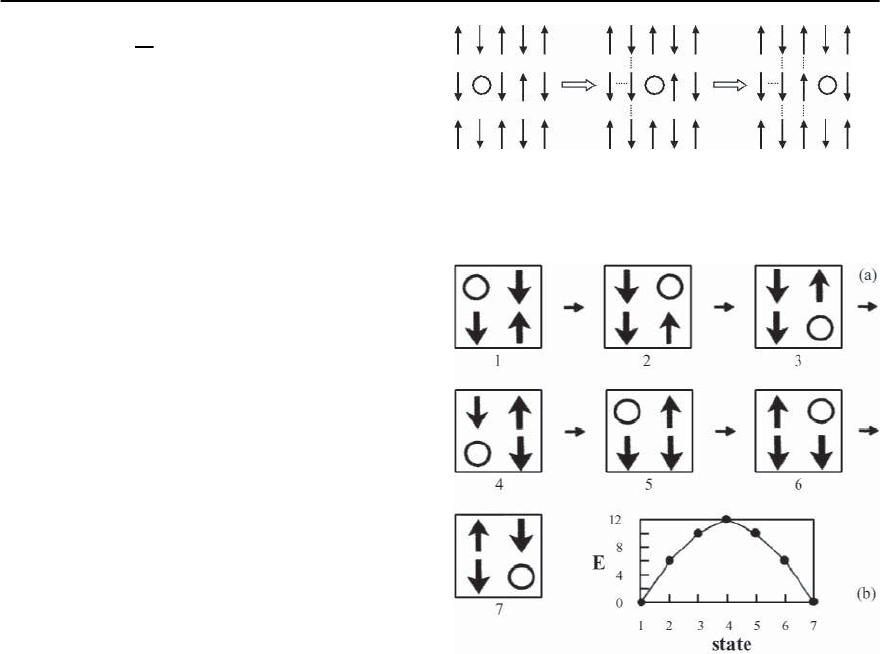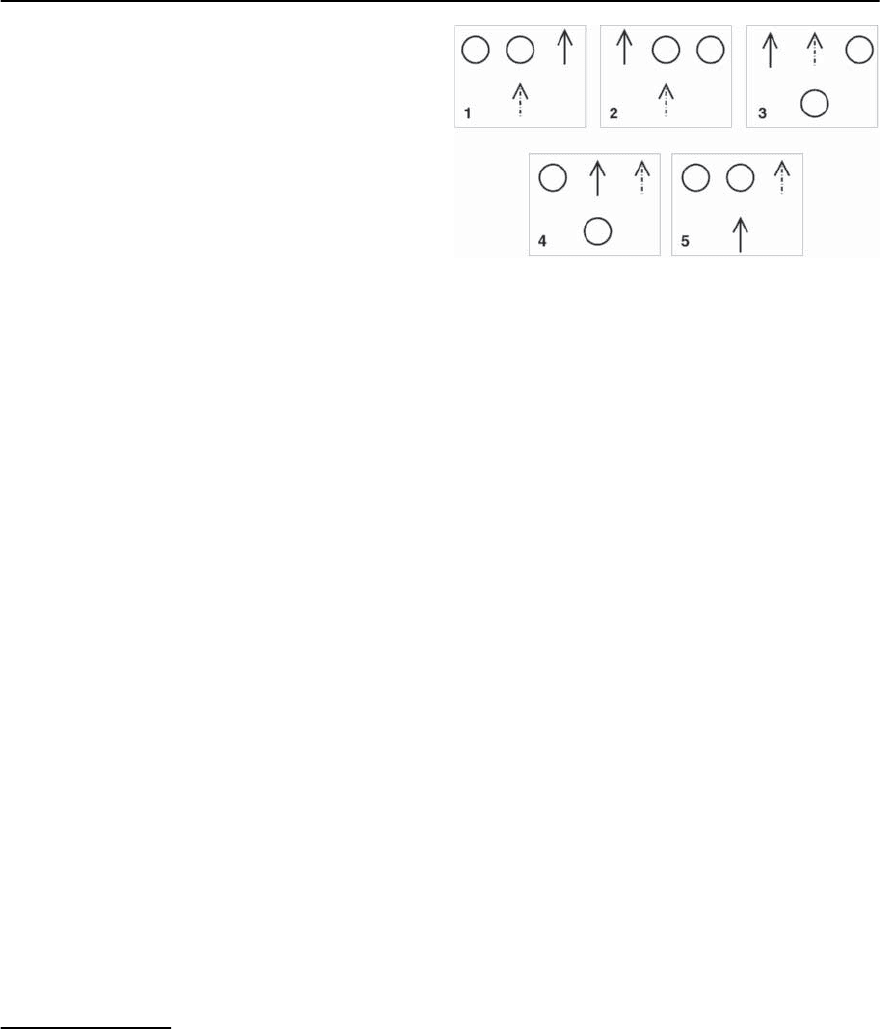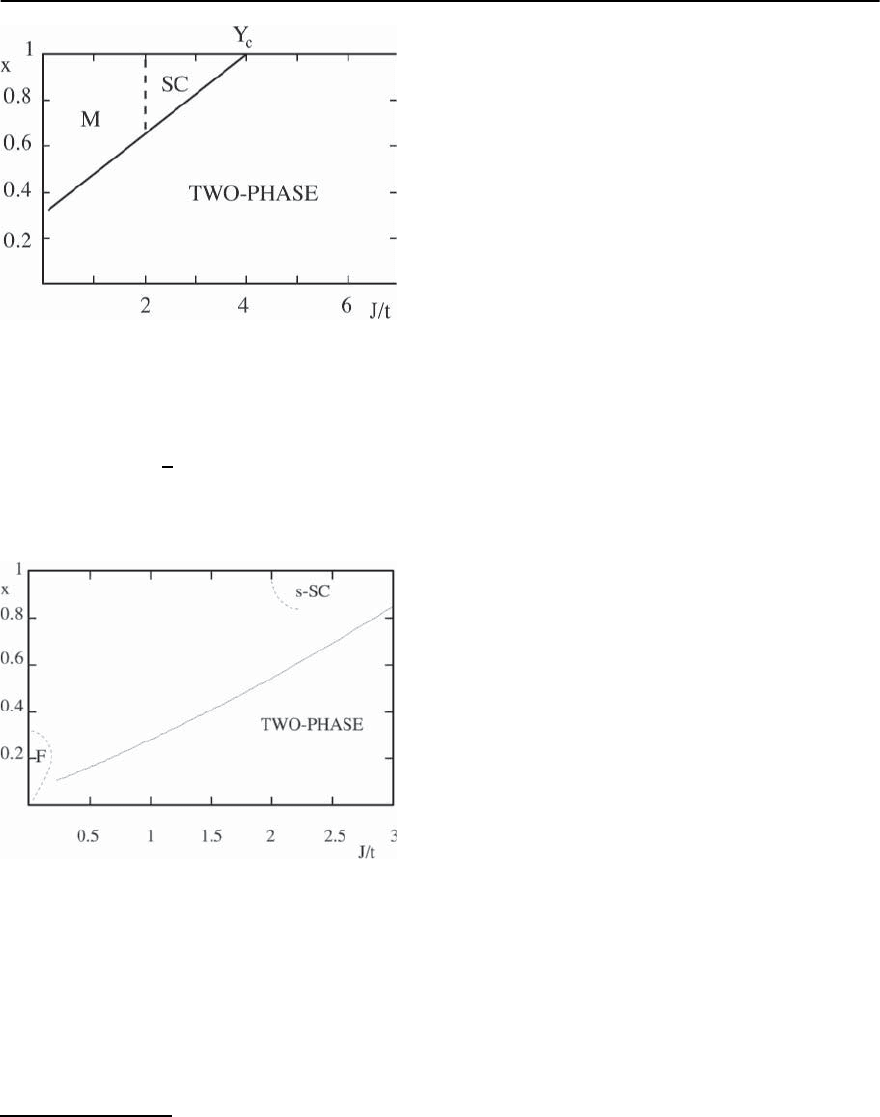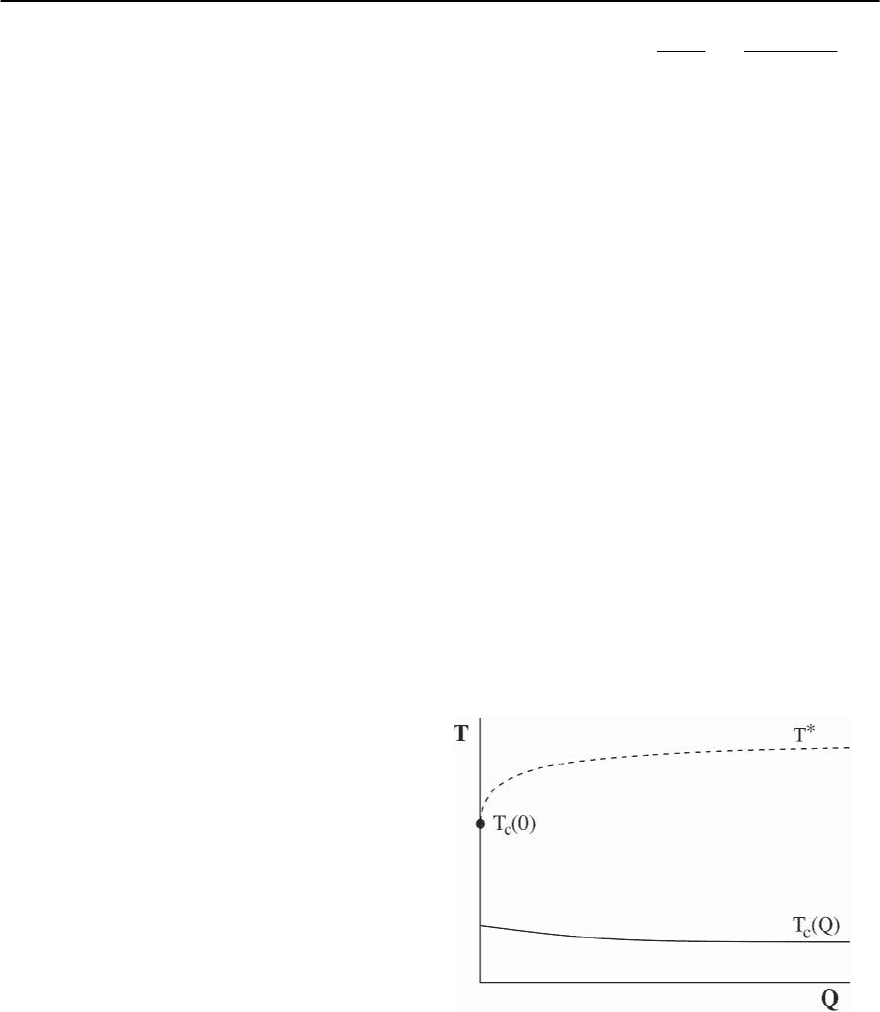Bennemann K.H., Ketterson J.B. Superconductivity: Volume 1: Conventional and Unconventional Superconductors; Volume 2: Novel Superconductors
Подождите немного. Документ загружается.


21 Concepts in High Temperature Superconductivity 1301
H =−t
<i,j>,
c
†
i,
c
j,
+h.c.
+
<i,j>
=
JS
i
· S
j
+ Vn
i
n
j
>
, (21.125)
where S
i
=
,
c
†
i,
,
c
i,
isthespinofanelec-
tron on site i.Here are the Pauli matrices and
< i, j > signifies nearest neighbor sites on a hyper-
cubic lattice in d dimensions.There is a constraint of
no double occupancy on any site,
n
i
= £
c
†
i,
c
i,
=0, 1 . (21.126)
The concentration of doped holes, x,istakentobe
much smaller than 1, and is defined as
x = N
−1
j
n
j
, (21.127)
where N is the number of sites.
The essential feature of this model is that it em-
bodies a strong, short range repulsion between elec-
trons, manifest in the constraint of no double occu-
pancy.The exchange integral J arises through virtual
processes wherein the intermediate state has a dou-
bly occupied site, producing an antiferromagnetic
coupling. Doping is assumed to remove electrons
thereby producing a “hole” or missing spin which is
mobile because neighboring electrons can hop into
its place with amplitude t.
Like a good game, the rules are simple: antialign
adjacent spins, and let holes hop. And like any good
game, the winning strategy is complex. The ground
state of this model must simultaneously minimize
the zero point kinetic energy of the doped holes and
the exchange energy, but the two terms compete.
For t > J > xt, the problem is highly f rustrated.
The spatially confined wavefunction of a localized
hole has a high kinetic energy; the t term accounts
for the tendency of a doped hole to delocalize by
hopping from site to site. However, as holes move
through an antiferromagnet they scramble the spins:
each time a hole hops from one site to its nearest
neighbor, a spin is also moved one register in the
lattice, onto the wrong sublattice. So it is impossible
to minimize both energies simultaneously in d > 1.
Moreover, in the physically relevant range of param-
eters, t > J > tx, neither energy is dominant. On the
one hand, because t > J, one cannot simply perturb
about the t = 0 state which minimizes the exchange
energy.On the other hand,because J > tx one cannot
simply perturb about the ground state of the kinetic
energy.
A number of strategies, usually involving further
generalizations of the model, have been applied to
the study of this problem, including: large n [427],
large S [428,429], large d [430], small t/J [392], large
t/J [392,431,432], and various numerical studies of
finite size clusters.(Some of the latter are reviewed in
Sect. 21.11.) For pedagogic purposes, we will frame
aspects of the ensuing discussion in terms of thelarge
d behavior of the model since it is tractable, and in-
volves no additional theoretical technology, but sim-
ilar conclusions can be drawn from a study of any of
the analytically tractable limits listed above.
28
One
common feature
29
of these solutionsis a tendency of
the doped holes to phase separate at small x.Therea-
son for this is intuitive:in a phase separated state,the
holes are expelled from the pure antiferromagnetic
fraction of the system, where the exchange energy is
minimized and the hole kinetic energy is not an issue,
while in the hole rich regions, the kinetic energy of
the holes is minimized, and the exchange energy can
be neglected to zeroth order since J < tx
rich
,where
x
rich
is the concentration of doped holes in the hole
rich regions.
A large dimension expansion
We employ the following large dimension strategy.
We take as the unperturbed Hamiltonian the Ising
piece of the interaction:
H
o
=
<i,j>
=
J
z
S
z
i
S
z
j
+ Vn
i
n
j
>
, (21.128)
and treat as perturbations the XY piece of the inter-
action and the hopping:
28
In some ways,the largeS limit is themost physically transparent ofall theseapproaches; see[429] for furtherdiscussion.
29
It is still controversial whether or not phase separation is universal in d = 2 and 3 at small enough x;see
[352,359,390,399,433–435].

1302 E.W. Carlson et al.
H
1
=
J
⊥
2
<i,j>
S
+
i
S
−
j
+h.c.
, (21.129)
H
2
=−t
<i,j>,
c
†
i,
c
j,
+h.c.
. (21.130)
Expansions derived in powers of J
⊥
/J
z
and t/J
z
can
be reorganized in powers of 1/d [430],atwhich point
we will again set J
⊥
= J
z
≡ J as in the original model
(Eq.(21.125)),and allow the ratio t/J to assume phys-
ical values.
OneHoleinanAntiferromagnet
It is universally recognized that a key principle gov-
erning the physics of doped antiferromagnets is that
the motion of a single hole is highly frustrated.
The motion of one hole in an antiferromagnet is frus-
trated.
To illustrate this point, it is convenient to examine
it from the perspective of a large dimension treat-
ment in which the motion of one hole in an antifer-
romagnet is seen to be frustrated by a “string” left
in its wake (see Fig. 21.41), which costs an energy
of order (d −1)J times the length of the string. The
unperturbed ground state of one hole on, say, the
“black” sublattice, is N/2-fold degenerate (equal to
the number of black sublattice sites), once a direc-
tion for the N´eel order is chosen (the other N/2de-
generate ground states describing a hole on the“red”
sublatticeforma disjoint Hilbert space under the op-
eration of H
1
and H
2
). These ground states are only
connected in degenerate perturbation theory of third
orhigherorder,via, e.g.two operationsof H
2
andone
of H
1
. They are connected in perturbation theory of
sixth or higher order by operations solely of the hop-
ping term H
1
via the Trugman [436] terms, in which
a hole traces any closed, nonintersecting path two
steps less than two full circuits; see Fig. 21.42 for an
example (such paths become important when J t).
In this manner a hole can“eat its own string”.Owing
to such processes a hole can propagate through an
antiferromagnet. However,the high order in the per-
turbation series and the energetic barriers involved
Fig. 21.41. Frustration of one hole’s motion in an antifer-
romagnet. As the hole hops, it leaves behind a string of
frustrated bonds designated here by dashed lines
Fig. 21.42. Tr u gman terms. (a)A hole movingoneanda half
times around a plaquette translates a degenerate ground
state without leaving a frustrated string of spins behind.
(b) The energy of the intermediate states in units of J.
The hole has to tunnel through this barrier as it moves.
From [436]
render the effective hopping matrix elements signif-
icantly smaller than their unperturbed values.
Two Holes in an Antiferromagnet
In early work on high temperature superconductiv-
ity, it was often claimed that, whereas the motion of
a single hole is inhibited by antiferromagnetic order,
pair motion appears to be entirely unfrustrated. It
was even suggested [19] that this might be the ba-
sis of a novel, kinetic energy driven mechanism of
pairing—perhapsthefirst such suggestion.However,
a flaw with this argument was revealed in the work of

21 Concepts in High Temperature Superconductivity 1303
Trugman [436], who showed that this mode of prop-
agation of the hole pair is frustrated by a quantum
effect which originates from the fermionic character
of the background spins. While Trugman’s original
argument was based on a careful analysis of numer-
ical studies in d = 2, the same essential effect can be
seen analytically in the context of a large d expan-
sion. The effective Hamiltonian of two holes can be
written as follows [430]:
H
eff
2
= U
eff
<i,j>
c
†
i
c
†
j
c
j
c
i
(21.131)
− T
eff
<i,j,k >
c
†
j
c
†
i
c
j
c
k
+ O(1/d
2
) ,
where< i, j, k > signifies asetof sitessuch thati and
k are both nearest neighbors of j,andthec
†
i
creates a
hole at site i. To lowest order in (1/d), U
eff
= V − J/4
and T
eff
= t
2
/Jd. For states with the two holes as
nearest neighbors, H
eff
2
can be block diagonalized by
Fourier transform, yielding d bands of eigenstates
labeled by a band index and a Bloch wavevector k.
The result is that d − 1 of these bands have energy
U
eff
and do not disperse. The remaining band has
energy U
eff
+4T
eff
d
a=1
sin
2
(k
a
/2), where k
a
is the
component of k along a. This final band, which feels
the effects of pair propagation,has the largest energy.
Two holes are no less frustrated.
This counterintuitive result follows from the
fermionic nature of the background spins. A sim-
ilar calculation for bosons would differ by a mi-
nus sign: in that case, the final band has energy
U
eff
−4T
eff
d
a=1
sin
2
(k
a
/2), which is much closer
to what one might have expected.
30
The interfer-
ence effect for the fermionic problem is illustrated in
Fig.21.43.Different paths that carry the system from
one hole pair configuration to another generally in-
terfere with each other, and when two such paths
differ by the exchange of two electrons, they inter-
fere destructively in the fermionic case and construc-
Fig. 21.43. Frustration of a h ole pair’s motion in an anti-
ferromagnet. The figure shows a sequence of snapshots in
a process that takes a pair of holes back to their original
position, but with a pair of spins switched.The sequence is
as follows: (1) Initial two hole state. (2) A spin has moved
two sites to the left. (3) The other spin has moved one site
up. (4) A hole has moved two sites to the left. (5)Ahole
has moved up. Due to the fermionic nature of the spins,
the above process leads to an increase in the pair energy,
so that pair propagation is not an effective mechanism of
pair binding
tively in the bosonic. It follows from this argument
that pair motion, too, is frustrated—it actually re-
sults in an effective kinetic repulsion between holes,
rather than in pair binding.
31
Many Holes: Phase Separation
In large d, the frustration of the kinetic energy of
doped holes in an antiferromagnet leads to a misci-
bility gap [430]. Perhaps this should not be surpris-
ing, since phase separation is the generic fate of mix-
tures at low temperatures. At any finite temperature,
two-phase coexistence occurs whenever the chem-
ical potentials of the two phases are equal. In the
present case, one of the phases, the undoped anti-
ferromagnet, is incompressible, which means that at
T = 0 its chemical potential lies at an indetermi-
nate point within the Mott gap. Under these circum-
stances, phase coexistence is instead established by
considering the total energy of the system:
30
This corrects similar expressions in [430].
31
It is apparent that second neighbor hopping terms, t
, produce less frustration of the single particle motion, and
“pair hopping” terms, which arise naturally in the t/U expansion of the Hubbard model, lead to unfrustrated pair
motion [156]. However, t
is generally substantially smaller than t, and if pair hopping is derived from the Hubbard
model, it is of order J, and hence relatively small.

1304 E.W. Carlson et al.
E
tot
= N
AF
e
AF
+ N
h
e
h
= Ne
AF
+ N
h
(e
h
− e
AF
) , (21.132)
where N
AF
and N
h
are the number of sites occupied
by the undoped antiferromagnet and by the hole rich
phase, respectively; N = N
AF
+ N
h
; e
AF
is the energy
per site of the antiferromagnet and e
h
is the energy
per site of the hole rich phase, in which the concen-
tration of doped holes is x
rich
= x(N/N
h
) ≥ x.IfE
tot
has a minimum with respect to N
h
at a value N
h
< N,
there is phase coexistence. This minimization leads
to the equation
=
e
AF
− e
h
()
1−n()
, (21.133)
where is the chemical potential of the hole rich
phase, and n =1−x
c
is the electron density in the
hole rich phase.
As we shall see, in the limit of large dimension,
n() (and hence e
h
as well) is either 0 or exponen-
tially small, so Eq. (21.133) reduces to
≈ e
AF
. (21.134)
Phase separation occurs below a critical concentra-
tion of doped holes.
We can see already how phase separation can tran-
spire. As the electron density is raised from zero ( i.e.
starting from x =1andloweringx),the chemical po-
tential of the electron gas increases. Once reaches
e
AF
, the added electrons must go into the antiferro-
magnetic phase, and the density of the electron gas
stops increasing. We can employ a small k expansion
of the electronic dispersion,(k)=−2td +tk
2
+...,to
determine that ≈ −2td + tk
2
F
.Thusife
AF
< −2td,
the electron gas is completely unstable, and there is
phase separation into the pure antiferromagnet, and
an insulating hole rich phase with n =0.Inthiscase,
x
c
= 1. Otherwise, the density of the electron gas is
n =
2A
d
d
k
F
2
d
=
2A
d
d
( +2td)/t
2
d
.
(21.135)
Here A
d
isthehypersurfaceareaofad dimensional
unit sphere. In large d, the energy per site of the pure
antiferromagnet approaches thatof theclassical N´eel
state:
e
AF
=−d
J
4
− V
[1 + O(1/d
2
)] . (21.136)
From this, it follows that the hole rich phase is insu-
lating ( i.e. it has no electrons) if J −4V > 8t and it is
metallic (x
c
< 1) if J −4V < 8t. However, even when
the hole rich phase is metallic, its electron density is
exponentially small (as promised):
n =1−x
c
=
2
√
d
e
1−
J −4V
8t
d/2
× [1 + O(1/d)] , (21.137)
wherewehaveusedtheasymptoticlarged ex-
pression [430] A
d
≈
d
(
2e
d
)
d/2
.Asillustratedin
Fig.21.44in larged,solongas0 < x < x
c
,theground
state of the t − J − V model is phase separated, with
an undoped antiferromagnetic region and a hole rich
regionwhich,if 8t > J −4V,isa Fermi liquidofdilute
electrons, or if 8t < J −4V,isaninsulator.(Under
thesesamecircumstances,ifx
c
< x < 1,the ground
state is a uniform, Fermi liquid metal.
32
)
In the low dimensions of physical interest, suchas
d =2andd = 3, the quantitative accuracy of a large
dimension expansion is certainly suspect. Nonethe-
less, we expect the qualitative physics of d =2and
d = 3 to be captured in a large dimension treatment,
since the lower critical dimension of most long range
T = 0 ordered states is d = 1.Forcomparison,in
Fig. 21.45 we reproduce the phase diagram of the 2D
t − J model which was proposed by Hellberg and
Manousakis [352] on the basis of Monte Carlo stud-
ies of systems with up to 60 electrons.There is clearly
substantial similarity between this and the large D
result in Fig. 21.44.
In one sense phase separation certainly can be
thought of as a strong attractive interaction between
holes, although in reality the mechanism is more
properly regarded as the ejection of holes from the
32
This statement neglects a possible subtlety due to the Kohn–Luttinger theorem.

21 Concepts in High Temperature Superconductivity 1305
Fig. 21.44. Phase diagram of the t − J model deduced from
large the d expansion. In the figure, we have set d =2.
“Two-phase” labels the region in which phase separation
occurs between the pure antiferromagnet and a hole rich
phase, “SC” labels a region of s-wave superconductivity,
and “M”labels a region of metallic behavior. At parametri-
cally small J/t ∝ 1/
√
d, a ferromagnetic phase intervenes
at small doping. From [430]
Fig. 21.45. Phase diagram of the t − J model in two dimen-
sions at zero temperature, deduced from numerical stud-
ies with up to 60 electrons. Tw o- phas e labels the region of
phase separation, s-SC labels a region of s-wave supercon-
ductivity, and F labels a region of ferromagnetism. This
figure is abstracted from Hellberg and Manousakis [352]
antiferromagnet.
33
The characteristic energy scale of
this interaction is set by magnetic energies, so one
expects to see phase separation only at temperatures
that are small compared to the antiferromagnetic ex-
change energy J.
21.12.2 Coulomb Frustrated Phase Separation and
Stripes
Were holes neutral, phase separation would be a
physically reasonable solution to the problem of frus-
trated hole motion in an antiferromagnet. But there
is another competition if the holes carry charge. In
this case, full phase separation is impossible because
of the infinite Coulomb energy density it would en-
tail. Thus, there is a second competition between the
short range tendency to phase separation embodied
in the t − J model, and the long range piece of the
Coulomb interaction. The compromise solution to
this second level of frustration results in an emer-
gent length scale [437]—a crossover between phase
separation on short length scales, and the required
homogeneity on long length scales.
Stripes are a unidirectional density wave.
Dependingupon microscopic details,many solutions
are possible [438] which are inhomogeneous on in-
termediate length scales, such as checkerboard pat-
terns, stripes, bubbles, or others.
Of these,thestripesolution is remarkably stable in
simple models [392,430,439],andmoreover is widely
observed in the cuprates [6]. A stripe state is a uni-
directional density wave state—we think of such a
state,at an intuitive level, as consisting of alternating
strips of hole rich and hole poor phase. A fully or-
dered stripe phase has charge density wave and spin
density wave order interleaved.
Certain aspects of stripe states can be made pre-
cise on the basis of long distance considerations. If
we consider the Landau theory [45] of coupled order
parameters for a spin density wave S with ordering
vector k and a charge density wave with ordering
vector q,thenif2k ≡ q (where ≡, in this case, means
equal modulo a reciprocal lattice vector), then there
is a cubic term in the Landau free energy allowed by
symmetry,
F
coupling
=
stripe
−q
S
k
· S
k
+C.C.
. (21.138)
33
Like salt crystallizing from a solution of salt water, the spin crystal is pure.

1306 E.W. Carlson et al.
There are two important consequences of this term.
Firstly, the system can lower its energy by locking
the ordering vectors of the spin and charge density
wave components of the order, such that the period
of the spin order is twice that of the charge order. At
order parameter level, is the origin of the antiphase
character of the stripe order.
34
Secondly,because this
term is linear in ,it means that if there is spin order,
< S
k
>=0,theremustnecessarily
35
be charge order,
<
2k
>= 0, although the converse is not true.
The Landau theory also allows us to distinguish
three macroscopically distinct scenarios for the on-
set of stripe order. If charge order onsets at a higher
critical temperature, and spin order either does not
occur, or onsets at a lower critical temperature, the
stripe order can be called“charge driven.”If spin and
charge order onset at the same critical temperature,
but the charge order is parasitic, in the sense that
<
2k
>∼< S
k
>
2
, the stripe order is “spin driven.”
Finally,if chargeand spinorderonsetsimultaneously
by a first order transition, the stripe order is driven
by the symbiosis between charge and spin order.This
is discussed in more detail in [45].
The antiphase nature of the stripes was first pre-
dicted by the Hartree–Fock theory and has been
confirmed as being the most probable outcome in
various later, more detailed studies of the problem
[350,409,410,441]. In this case, the spin texture un-
dergoes a phase shift across every charge stripe,
so that every other spin stripe has the opposite N´eel
vector, canceling out any magnetic intensity at the
commensurate wavevector, < , >.Thissituation
[442,443] has been called “topological doping.”And,
indeed, the predicted factor of two ratio between the
spin and chargeperiodicities has been observedin all
well established experimental realizations of stripe
order in doped antiferromagnets [47]. Still, it is im-
portant to remember that nontopological stripes are
also a logical possibility [409,410,433,440,444,445],
and we should keep our eyes open for this form of
order, as well.
36
The Coulomb interaction sets the stripe spacing.
In the context of frustrated phase separation, the
formation of inhomogeneous structures is predom-
inantly a statement about the charge density, and
its scale is set by the Coulomb interaction. This has
several implications. Firstly, this means that charge
stripes may begin to self-organize (at least locally)
at relatively high temperatures, i.e. they are charge
driven in the sense described above.
37
Secondly,
charge density wave order always couples linearly to
lattice distortions, so we should expect dramatic sig-
natures of stripe formationto show up in the phonon
spectrum. Indeed, phonons may significantly affect
the energetics of stripe formation [446]. Thirdly, al-
though we are used to thinking of density wave states
as insulating, or at least as having a dramatically re-
duced density of states at the Fermi energy, this is
not necessarily true.
Competition sets the hole concentration on a stripe.
Iftheaverageholeconcentrationoneachstripeisde-
termined primarily by the competition between the
Coulomb interaction and the local tendency to phase
separation,the linear hole density per site along each
stripe can vary as a function of x and consequently
there is no reason to expect the Fermi energy to lie in
a gap or pseudogap.In essence,stripes may be intrin-
sically metallic, or even superconducting. Moreover,
such compressible stripes are highly prone to lattice
commensurability effectswhich tend to pintheinter-
stripe spacing at commensurate values.Conversely,if
the stripes are a consequence of some sort of Fermi
surface nesting, as is the case in the Hartree-Fock
studies [405,408,447] of stripe formation,the stripe
34
In the context of Landau–Ginzberg theory, the situation is somewhat more complex, and whether the spin and charge
order have this relation, or have the same period turns out to depend on short distance physics, see footnote 36
and [440].
35
Here, we exclude the possibility of perfectly circular spiral spin order, in which Re{< S >}·Im{< S >} =0and
[Re{< S >}]
2
=[Im{< S >}]
2
=0.
36
For example, an analogous Landau theory of stripes near the N´eel state must include the order parameter S
,which
favors in-phase domain walls [440].
37
In Hartree-Fock theory, stripes are spin driven.

21 Concepts in High Temperature Superconductivity 1307
period always adjusts precisely so as to maintain a
gap or pseudogap atthe Fermi surface:there is always
one doped hole per site along each charge stripe.This
insulating behavior is likelya generic feature ofall lo-
cal models of stripe formation [442], although more
sophisticated treatments can lead to other preferred
linear hole densities along a stripe [350,404].
In short, stripe order is theoretically expected to
be a common form of self-organized charge order-
ing in doped antiferromagnets. In a d-dimensional
striped state, the doped holes are concentrated in an
ordered array of parallel (d −1)dimensionalhyper-
surfaces: solitons in d = 1,“rivers of charge”in d =2,
and sheets of charge in d = 3. This “charge stripe
order” can either coexist with antiferromagnetism
with twice the period (topological doping) or with
the same period as the charge order, or the magnetic
order can be destroyed by quantum or thermal fluc-
tuations of the spins.
“Stripe glasses” and “st ripe liquids” are also possible.
Moreover, the stripes can be insulating, conducting,
or even superconducting. It is important to recall
that for d < 4 quenched disorder is always a rele-
vant perturbation for charge density waves [448], so
rather than stripe ordered states, real experiments
may often require interpretation in terms of a“stripe
glass”[449–452].Finally,formany purposes,it is use-
ful to think of systems that are not quite ordered, but
have substantial short range stripe order as low fre-
quency fluctuations, as a “fluctuating stripe liquid”.
We will present an example of such a state in the next
subsection.
21.12.3 Avoided Critical Phenomena
Let us examine a simple model of Coulomb frus-
trated phase separation.We seek to embody a system
with two coexistingphases,which are forcedto inter-
leave due to the charged nature of one of the phases.
To account for the short range tendency to phase
separation,we include a short range“ferromagnetic”
interaction which encourages nearest neighbor re-
gions to be of the same phase, and also a long range
“antiferromagnetic” interaction which prevents any
domain from growing too large:
H =−L
<i,j>
S
i
·S
j
+
Qa
d−2
2
i=j
S
i
·S
j
|R
i
− R
j
|
d−2
.
(21.139)
Here S
j
is an N component unit vector, S
i
· S
i
=1,L
is a nearest neighbor ferromagnetic interaction, Q is
an antiferromagnetic “Coulomb” term which repre-
sents the frustration (and is always assumed small,
Q L), d is the spatial dimension, < i, j > signifies
nearest neighbor sites, a is the lattice constant, and
R
j
is the location of lattice site j.TheIsing(N =1)
version of this model is the simplest coarse grained
model [390,453] of Coulomb frustrated phase sepa-
ration, in which S
j
= 1 represents a hole rich, and
S
j
= −1 a hole poor region. In this case, L > 0
is the surface tension of an interface between the
two phases, and Q is the strength of the Coulomb
frustration. While the phase diagram of this model
has been analyzed [453] at T = 0, it is fairly com-
plicated, and its extension to finite temperature has
only been attempted numerically [454].However, all
the thermodynamic properties of this model can be
obtained [455,456] exactly in the large N limit.
Figure 21.46 shows the phase diagram for this
model. Both for Q =0andQ =0,thereisalow
temperature ordered state, but the ordered state is
fundamentally different for the two cases. For the
unfrustrated case,the ordered state is homogeneous,
Fig. 21.46. Schematic phase diagram of the model in Eq.
(21.139) of avoided critical phenomena. The thick black
dot marks T
c
(Q = 0), the ordering temperature in the ab-
sence of frustration; this is “the avoided critical point”.
Notice that T
c
(Q → 0) < T
c
(Q = 0).From [456]

1308 E.W. Carlson et al.
whereas with frustration,there is an emergent length
scale in the ordered state which governs the modula-
tion of the order parameter.To be specific,in dimen-
sions d > 2 and for N > 2, there is a low tempera-
ture ordered unidirectional spiral phase, which one
can think of as a sort of stripe ordered phase [456].
Clearly, as Q → 0, the modulation length scale must
diverge, so that the homogeneous ordered state is
recovered. However, like an antiferromagnet doped
with neutral holes, there is a discontinuous change
in the physics from Q = 0 to any finite Q: for d ≤ 3,
lim
Q→0
T
c
(Q) ≡ T
c
(0
+
)isstrictlylessthanT
c
(0). In
other words, an infinitesimal amount of frustration
depresses the ordering temperature discontinuously.
This model exhibits a “fluctuating stripe” phase.
Although forany finiteQ the system does not experi-
ence a phase transition as the temperature is lowered
through T
c
(0), the avoided critical point heavily in-
fluences the short range physics.For temperatures in
the range T
c
(0) > T > T
c
(0
+
), substantial local or-
der develops.An explicit expression for the spin-spin
correlator can be obtained in this temperature range:
At distances less than the correlation length
0
(T)of
the unfrustrated magnet, R
ij
<
0
(T), the correlator
is critical,
S
i
· S
j
∼
a/R
ij
d−2−
, (21.140)
but for longer distances, R
ij
>
0
(T), it exhibits a
damped version of the Goldstone behavior of a fluc-
tuating stripe phase,
S
i
· S
j
∼
a/R
ij
d−1
2
cos[KR
ij
]exp[−R
ij
] .
(21.141)
At T
c
(Q), the wavevector K is equal to the stripe or-
dering wavevector of the low temperature ordered
state, K(T
c
)=(Q/L)
1/4
.Asthetemperatureisraised,
K decreases until it vanishes at a disorder line
marked T
∗
in the figure. The inverse domain size
is given by
(T)=
(Q/L)
1/4
− K
2
(T) . (21.142)
For a broad range of temperatures (which does not
narrow as Q → 0), this model is in a fluctuating
stripe phase in a sense that can be made arbitrarily
precise for small enough Q.
21.12.4 The Cuprates as Doped Antiferromagnets
General Considerations
Our theoretical understanding of the undoped anti-
ferromagnets is extolled.
There is no question that the undoped parents of
the high temperature superconductors are Mott in-
sulators, in which the strong short range repulsion
between electrons is responsible for the insulating
behavior, and the residual effects of the electron ki-
netic energy (superexchange) lead to the observed
antiferromagnetism.Indeed,oneof thegreattheoret-
ical triumphsof the field is the complete description,
based on interacting spin waves and the resulting
nonlinear sigma model, of the magnetism in these
materials [222,223,327].
However, it is certainly less clear that one should
inevitably view the superconducting materials as
doped antiferromagnets, especially given that we
have presented strong reasons to expect a first or-
der phase transition between x =0andx > 0.
Nonetheless, many experiments on the cuprates are
suggestiveof a dopedantiferromagnetic character.In
the first place, various measurements of the density
of mobile charge, including the superfluid density
[107,243], the “Drude weight” measured in optical
conductivity [457], and the Hall number [458,459],
are all consistent with a density proportional to the
doped hole density, x, rather than the total hole den-
sity, 1 + x,expected from a band structure approach.
Moreover, over a broad range of doping, the cuprates
retain a clear memory of the antiferromagnetism
of the parent correlated insulator. Local magnetism
abounds.NMR,SR,and neutron scattering find evi-
dence (some of which is summarized in Sect.21.13.1)
of static, or slowly fluctuating,spin patterns, includ-
ing stripes, spin glasses, and perhaps staggered or-
bital currents.
Why the cuprates should be v iewed as doped antifer-
romagnets
Static magnetic moments, or slowly fluctuating ones,
are hard to reconcile with a Fermi liquid picture.
There is also some evidence from STM of local elec-
tronic inhomogeneity [100, 101, 460] in BSCCO, in-
dicative of the short range tendency to phase sepa-

21 Concepts in High Temperature Superconductivity 1309
rate.The Fermi liquid state in a simple metal is highly
structured in k-space, and so is highly homogeneous
(rigid) in real space.This is certainly in contrast with
experiments on the cuprates which indicate signifi-
cant real space structure.
Stripes
There is increasingly strong evidence that stripe cor-
relations,as a specific feature of doped antiferromag-
nets, occur in at least some high temperature super-
conducting materials.
Another triumph of theor y!
The occurrenceof stripe phases in the high tempera-
ture superconductors in particular, and in doped an-
tiferromagnets more generally, was successfully pre-
dicted
38
by theory [405,408,447]. Indeed, it is clear
that a fair fraction of the theoretical inferences dis-
cussed in Sect. 21.12.2 are, at least in broad outline,
applicable to a large number of materials, including
at least some high temperature superconductors [6].
In particular, the seminal discovery [463] that in
La
1.6−x
Nd
0.4
Sr
x
CuO
4
, first charge stripe order, then
spin stripe order, and then superconductivity onset
at successively lower critical temperatures is consis-
tent with Coulomb frustrated phase separation (see
Fig. 21.47 in Sect. 21.13.1). Somewhat earlier work
on the closely related nickelates [464] established
that the charge stripes are,indeed,antiphase domain
walls in the spin order.
Controversy remains as to how universal stripe
phases are in the cuprate superconducting materials,
and even how the observed phases should be pre-
cisely characterized. This is also an exciting topic, on
which there is considerable ongoing theoretical and
experimental study. We will defer further discussion
of this topic to Sect. 21.13.
21.12.5 Additional Consid erations and Alternative
Perspectives
There are a number of additional aspects of this
problem which we havenot discussedhere,but which
we feel warrant a mention. In each case, clear discus-
sions exist in the literature to which the interested
reader is directed for a fuller exposition.
Phonons
There is no doubt that strong electron-phonon cou-
pling can drive a system to phase separate. Strong
correlation effects necessarily enhance such tenden-
cies, since they reduce the rigidity of the electron
wavefunction to spatial modulation.(See, e.g.the 1D
example in Sect. 21.9.2.) In particular, when there is
already a tendency to some form of charge ordering,
on very general grounds we expect it to be strongly
enhanced by electron-phonon interactions.
This observation makes us very leery of any at-
temptataquantita tive comparison between results
on phase separation or stripe formation in the t − J
or Hubbard models withexperiments in the cuprates,
where the electron-phonon interaction is manifestly
strong [465]. Conversely, there should generally be
substantial signatures of various stripe-related phe-
nomena in the phonon dynamics, and this can be
used to obtain an experimental handle on these be-
haviors [160]. Indeed, there exists a parallel devel-
opment of stripe-related theories of high tempera-
ture superconductivity based on Coulomb frustra-
tion of a phase separation instabilitywhich is driven
by strong electron-phonon interactions [16,61,466].
The similarity between many of the notions that
have emerged from these studies,and those that have
grown out of studies of doped antiferromagnets il-
lustrates both how robust the consequences of frus-
trated phase separation are in highly correlated sys-
tems, and how difficult it is to unambiguously iden-
tify a “mechanism” for it. For a recent discussion of
many of the same phenomena discussed here from
this alternative viewpoint, see [62].
Spin-Peierls Order
Another approach to this problem, which emerges
naturally from an analysis of the large N limit [71],is
38
The theoretical predictions predated any clear body of well accepted experimental facts, although in all fairness it
must be admitted that there was some empirical evidence of stripe-like structures which predated all of the theoretical
inquiry: Even at the time of the first Hartree–Fock studies,there was already dramatic experimental evidence [461,462]
of incommensurate magnetic structure in La
2−x
Sr
x
CuO
4
.

1310 E.W. Carlson et al.
to view the doped system as a“spin-Peierls”insulator,
by which we mean a quantum disordered magnet in
which the unit cell size is doubled but spin rotational
invariance is preserved.
39
While the undoped system
is certainly antiferromagnetically ordered, it is ar-
gued that when the doping exceeds the critical value
at which spin rotational symmetry is restored, the
doped Mott insulating features of the resulting state
are better viewed as if they arose from a doped spin-
Peierls state. Moreover, since the spin-Peierls state
has a spin gap,it can profitably be treated as a crystal
of Cooper pairs, which makes the connection to su-
perconductivity very natural. Finally, as mentioned
in Sect. 21.7, this approach has a natural connection
with various spin liquid ideas.
Interestingly, it turns out that the doped spin-
Peierls state also generically phase separates [427,
469–471]. When the effect of long range Coulomb
interactions are included, the result is a staircase of
commensurate stripe phases [471]. Again, the con-
vergence of the pictures emerging from diverse start-
ing points convinces us of the generality of stripey
physics incorrelatedsystems.For a recent discussion
of the physics of stripe phases, and their connection
to the cuprate high temperature superconductors ap-
proached from the large N/spin-Peierls perspective,
see [472].
Stripes in Other Systems
It is not only the robustness of stripes in variousthe-
ories that warrants mention, but also the fact that
they are observed, in one way or another, in diverse
physical realizations of correlated electrons. Stripes,
and even a tendency to electronic phase separation,
arebynowwelldocumentedinthemanganites—
the colossal magnetoresistance materials. (For re-
cent discussions, which review some of the literature,
see [17,473] and [108].) This system, like the nicke-
lates and cuprates,is a doped antiferromagnet,so the
analogy is quite precise.
Although the microscopic physics of quantum
Hall systems is quite different from that of doped
antiferromagnets, it has been realized for some time
[474, 475] that in higher Landau levels, a similar
drama occurs due to the interplay between a short
ranged attraction and a long range repulsion be-
tween electrons which gives rise to stripe and bub-
ble phases. Evidence of these, as well as quantum
Hall nematic phases [177,476], has become increas-
ingly compelling in recent years. (For a recent re-
view, see [178].) On a more speculative note, it has
been noticed that such behavior may be expected
in the neighborhood of many first order transitions
in electronic systems, and it has been suggested that
various charge inhomogeneous states may play a role
in the apparent metal-insulator transition observed
in the two-dimensional electron gas [477].
21.13 Stripes and High Temperature
Superconductivity
In this article, we have analyzed the problem of high
temperature superconductivity in a highlycorrelated
electron liquid, with particular emphasis on doped
antiferromagnets. We have identified theoretical is-
sues, and even some solutions. We have also dis-
cussed aspects of the physics that elude a BCS de-
scription. This is progress.
However, we have not presented a single, unified
solution to the problem. Contrast this with BCS, a
theory so elegant it may captured in haiku:
Instability
Of a tranquil Fermi sea –
Broken symmetry.
Of course, to obtain a more quantitative understand-
ing of particular materials would require a few more
verses—we might need to study the Eliashberg equa-
tionsto treatthephonon dynamicsin a morerealistic
fashion,andwemayneed toincludeFermiliquidcor-
rections,andwe may also haveto waveour handsa bit
about
∗
, etc. But basically, in the context of a single
approximate solution of a very simple model prob-
lem, we obtain a remarkably detailed and satisfac-
tory understanding of the physics.And while we may
notbeabletocomputeT
c
very accurately—it does,
after all, depend exponentially on parameters—we
can understand what sort of metals will tend to be
39
Alternatively, this state can be viewed as a bond-centered charge density wave [467,468].
